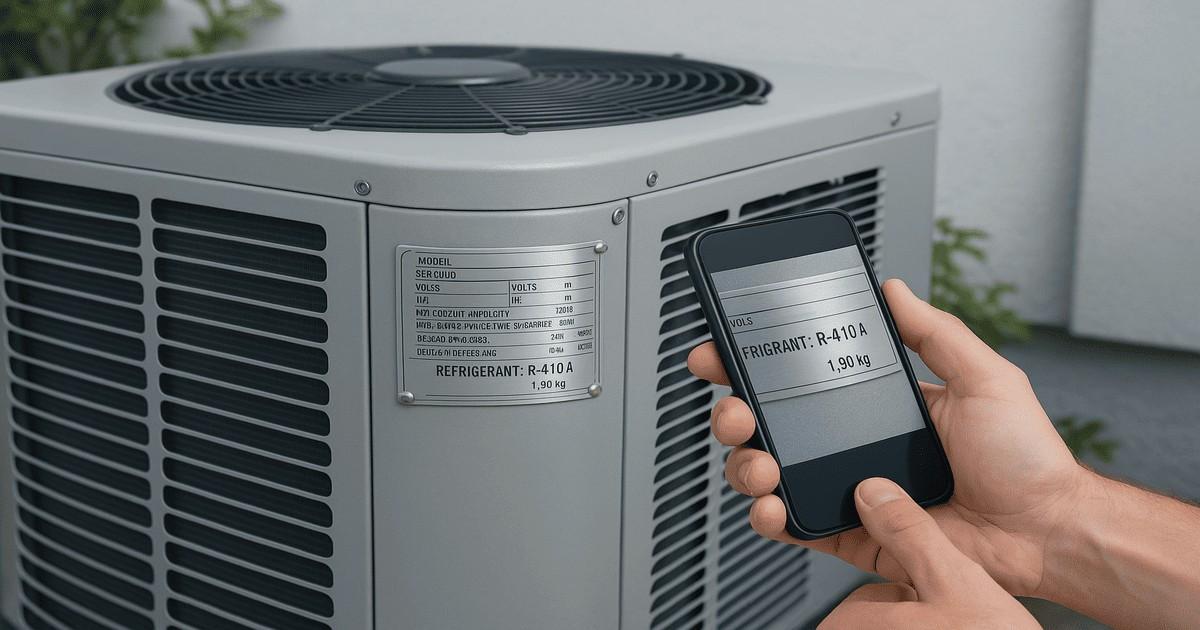If you’ve been wondering how to determine what refrigerant is in ac, you’re not alone. Many homeowners and renters are unaware of the type of refrigerant their air conditioner uses until a repair or recharge is needed. Knowing the refrigerant type is important for maintenance, energy efficiency, environmental compliance, and even your wallet.
In this guide, you’ll learn simple, reliable methods to identify the refrigerant inside your AC — whether it’s a central unit, window AC, or a Samsung split system — along with answers to common questions like how to tell if your AC is R-22 or R-410A, how to identify AC gas type, and which refrigerant is better for your needs.
1. Why Knowing Your AC Refrigerant Matters
Your air conditioner cools by circulating a chemical compound called refrigerant through coils and compressors. This substance absorbs heat inside your home and releases it outside. But not all refrigerants are created equal:
- Some, like R-22 (Freon), are being phased out because of their environmental impact.
- Others, like R-410A (Puron) and R-32, are more energy-efficient and environmentally friendly.
If you don’t know your refrigerant type, you might:
- Pay more for refills or service.
- Violate environmental rules unintentionally.
- Miss out on energy savings by sticking with an outdated refrigerant.
2. Understanding AC Refrigerants
Before we dive into how to identify your AC gas type, it helps to know the most common options:
- R-22 (Freon): Used in most ACs before 2010. Now banned from production in many countries.
- R-410A (Puron): The standard in most new residential ACs. Higher pressure, better cooling, more eco-friendly.
- R-32: A newer refrigerant used in many high-efficiency units, especially mini-splits and some Samsung or LG models.
- Automotive Refrigerants: Car AC systems use different types, like R-134a or R-1234yf.
Knowing which category your unit falls into helps narrow down your search.
3. Quick Ways to Identify the Refrigerant in Your AC
When you’re standing in front of your unit asking, “How to identify AC refrigerant?”, these steps are the simplest:
Check the Nameplate or Label
Most manufacturers clearly state the refrigerant type and charge amount on a data sticker or nameplate:
- On central or split systems, look on the outdoor condenser unit.
- On window ACs, check the back panel or inside the removable front grille.
- On portable ACs, the label may be near the power cord.
This sticker usually says something like: “Refrigerant: R-410A – 1.20 kg.” If it’s faded, take a photo with your phone and zoom in.
Read the User Manual
Lost your manual? Download it from the manufacturer’s website. Search for your model plus “manual PDF.” This is especially helpful if you’re asking, “How to determine what refrigerant is in AC Samsung?” or LG units.
Look at the Service Ports
Some technicians can tell at a glance from the size and color of the service ports which refrigerant the unit uses (for example, R-410A uses larger fittings). This isn’t 100% reliable for DIYers, but it’s a hint.
4. Using Model Numbers and Manufacturer Resources
Another overlooked method is decoding your model number. Type the full model number (found on the same label) into the manufacturer’s support page or a search engine. Many brands like Carrier, Daikin, LG, or Samsung list the refrigerant in their online specs.
This trick works across units, whether you’re trying to find the refrigerant in your window AC, your Samsung split unit, or even a commercial rooftop unit.
5. Ask a Professional or Use a Refrigerant Identifier
If the label is missing or unreadable, the safest option is to call a certified HVAC technician. Professionals carry tools like a Refrigerant Analyzer or Refrigerant Identifier. These devices test a sample from the system to tell exactly what type of gas is inside.
This is particularly important if:
- You bought a used AC.
- Your system was retrofitted or topped up by someone else.
- You suspect a refrigerant blend or contamination.
While hiring a technician costs more up front, it avoids mistakes that could damage your unit or violate regulations.
6. Safety Precautions Before Checking Your AC
Refrigerants are under high pressure and can cause frostbite or other injuries. Always:
- Turn off power to the unit before inspecting.
- Do not open sealed refrigerant lines yourself.
- Wear gloves and safety glasses if you’re near service ports.
If you’re unsure, stick to reading labels and manuals or call a pro.
7. How to Tell if Your AC Uses R-22 or R-410A
This is one of the most common homeowner questions: “How do I know if my AC is R-22 or R-410A?”
- Manufacture Date: Units made before 2010 almost always use R-22.
- Label Check: The refrigerant type is printed on the data plate.
- Pressure Fittings: R-410A systems run at much higher pressure and have different service port fittings.
If you discover your system uses R-22, know that this refrigerant is no longer produced in many countries. Supplies are limited and expensive. You’ll need to plan for either a full system replacement or a retrofit with an approved substitute.
8. What to Do if You Have an Outdated or Banned Refrigerant
Finding out your system runs on R-22 can be daunting. Here are your options:
- Keep Running It: You can still operate the unit legally, but repairs will be costly.
- Retrofit with an Approved Substitute: Some technicians can swap in drop-in replacements, but performance may vary.
- Replace the System: Often the most cost-effective in the long run, with better energy efficiency and warranties.
If you’re shopping for a new unit, consider which is better for your needs: R-32 or R-410A AC gas?
- R-32: Lower global warming potential (GWP), more efficient, but slightly flammable.
- R-410A: Non-flammable, widely available, but higher GWP.
Most new high-efficiency models use R-32, but either can cool your home effectively.
9. FAQs (People Also Ask)
How to identify AC refrigerant quickly?
Check the nameplate or label on your unit, consult the manual, or use a refrigerant analyzer.
How do I know if my AC is R-22 or R-410A?
Look at the manufacturing date and the label. Pre-2010 units are usually R-22; newer ones are typically R-410A.
How to identify AC gas type without a label?
If the label is missing, call an HVAC professional with a Refrigerant Identifier tool. They can test it safely.
Which is better, R-32 or R-410A AC gas?
R-32 is more eco-friendly and efficient, while R-410A is non-flammable and still widely used. Choose based on your region’s regulations and the availability of service technicians.
What type of refrigerant does my home AC use?
Most home ACs built after 2010 use R-410A. Check your unit’s label or manual to be sure.
What type of refrigerant is in my car?
Automotive AC systems typically use R-134a (older cars) or R-1234yf (newer cars), not the same refrigerants as home ACs.
10. Special Cases: Window ACs and Samsung Units
Many people specifically search “How to determine what refrigerant is in AC window” or “How to determine what refrigerant is in AC Samsung.”
- Window ACs: Check the back panel or underside for the refrigerant label. Newer models are often R-32.
- Samsung or LG Split Units: Look at the outdoor unit’s nameplate. These brands prominently display refrigerant type.
If you can’t find the label, download the official product sheet from the brand’s support page.
11. Tips to Stay Compliant and Save Money
- Keep Records: Save a photo of your refrigerant label for future service visits.
- Schedule Regular Maintenance: Low refrigerant could mean a leak, not just “needs gas.”
- Plan for Replacement: If you’re running R-22, budget for an upgrade within a few years.
By following these steps, you’ll protect your investment and the environment.
12. Conclusion
Learning how to determine what refrigerant is in ac is easier than most people think. Start by checking the data label or nameplate on your unit, reading the user manual, or looking up the model number online. If you still can’t identify it, call a certified HVAC professional who can test the system safely with a refrigerant identifier.
Whether you own a central system, a window AC, or a Samsung split unit, knowing your refrigerant type helps you plan maintenance, stay compliant with regulations, and decide when it’s time to upgrade. By following the tips in this guide, you’ll have a clear answer to how to determine what refrigerant is in ac and keep your cooling system running efficiently for years to come.
Also like to read: Martell Holt Net Worth 2025 – Career, Earnings & Lifestyle




